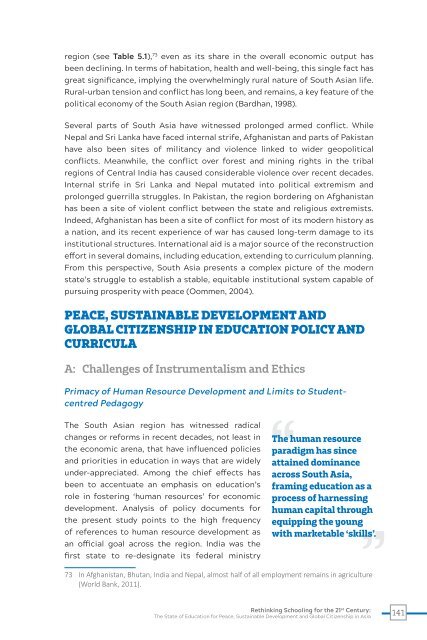Rethinking Schooling for the 21st Century
UNESCO MGIEP officially launched 'Rethinking Schooling for the 21st Century: The State of Education, Peace and Sustainable Development and Global Citizenship' in 2017 at the UNESCO General Conference. This study analyses how far the ideals of SDG 4.7 are embodied in policies and curricula across 22 Asian countries and establishes benchmarks against which future progress can be assessed. It also argues forcefully that we must redefine the purposes of schooling, addressing the fundamental challenges to efforts to promote peace, sustainability and global citizenship through education.
UNESCO MGIEP officially launched 'Rethinking Schooling for the 21st Century: The State of Education, Peace and Sustainable Development and Global Citizenship' in 2017 at the UNESCO General Conference. This study analyses how far the ideals of SDG 4.7 are embodied in policies and curricula across 22 Asian countries and establishes benchmarks against which future progress can be assessed. It also argues forcefully that we must redefine the purposes of schooling, addressing the fundamental challenges to efforts to promote peace, sustainability and global citizenship through education.
You also want an ePaper? Increase the reach of your titles
YUMPU automatically turns print PDFs into web optimized ePapers that Google loves.
egion (see Table 5.1), 73 even as its share in <strong>the</strong> overall economic output has<br />
been declining. In terms of habitation, health and well-being, this single fact has<br />
great significance, implying <strong>the</strong> overwhelmingly rural nature of South Asian life.<br />
Rural-urban tension and conflict has long been, and remains, a key feature of <strong>the</strong><br />
political economy of <strong>the</strong> South Asian region (Bardhan, 1998).<br />
Several parts of South Asia have witnessed prolonged armed conflict. While<br />
Nepal and Sri Lanka have faced internal strife, Afghanistan and parts of Pakistan<br />
have also been sites of militancy and violence linked to wider geopolitical<br />
conflicts. Meanwhile, <strong>the</strong> conflict over <strong>for</strong>est and mining rights in <strong>the</strong> tribal<br />
regions of Central India has caused considerable violence over recent decades.<br />
Internal strife in Sri Lanka and Nepal mutated into political extremism and<br />
prolonged guerrilla struggles. In Pakistan, <strong>the</strong> region bordering on Afghanistan<br />
has been a site of violent conflict between <strong>the</strong> state and religious extremists.<br />
Indeed, Afghanistan has been a site of conflict <strong>for</strong> most of its modern history as<br />
a nation, and its recent experience of war has caused long-term damage to its<br />
institutional structures. International aid is a major source of <strong>the</strong> reconstruction<br />
ef<strong>for</strong>t in several domains, including education, extending to curriculum planning.<br />
From this perspective, South Asia presents a complex picture of <strong>the</strong> modern<br />
state’s struggle to establish a stable, equitable institutional system capable of<br />
pursuing prosperity with peace (Oommen, 2004).<br />
PEACE, SUSTAINABLE DEVELOPMENT AND<br />
GLOBAL CITIZENSHIP IN EDUCATION POLICY AND<br />
CURRICULA<br />
A: Challenges of Instrumentalism and Ethics<br />
Primacy of Human Resource Development and Limits to Studentcentred<br />
Pedagogy<br />
The South Asian region has witnessed radical<br />
changes or re<strong>for</strong>ms in recent decades, not least in<br />
<strong>the</strong> economic arena, that have influenced policies<br />
and priorities in education in ways that are widely<br />
under-appreciated. Among <strong>the</strong> chief effects has<br />
been to accentuate an emphasis on education’s<br />
role in fostering ‘human resources’ <strong>for</strong> economic<br />
development. Analysis of policy documents <strong>for</strong><br />
<strong>the</strong> present study points to <strong>the</strong> high frequency<br />
of references to human resource development as<br />
an official goal across <strong>the</strong> region. India was <strong>the</strong><br />
first state to re-designate its federal ministry<br />
The human resource<br />
paradigm has since<br />
attained dominance<br />
across South Asia,<br />
framing education as a<br />
process of harnessing<br />
human capital through<br />
equipping <strong>the</strong> young<br />
with marketable ‘skills’.<br />
73 In Afghanistan, Bhutan, India and Nepal, almost half of all employment remains in agriculture<br />
(World Bank, 2011).<br />
<strong>Rethinking</strong> <strong>Schooling</strong> <strong>for</strong> <strong>the</strong> 21 st <strong>Century</strong>:<br />
The State of Education <strong>for</strong> Peace, Sustainable Development and Global Citizenship in Asia<br />
141

















